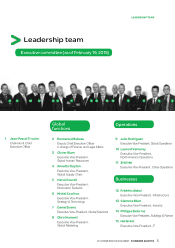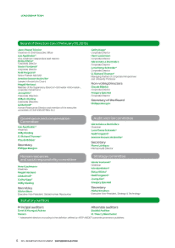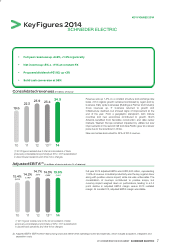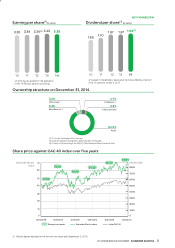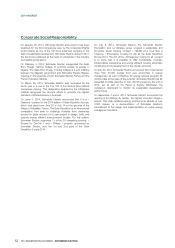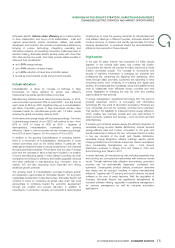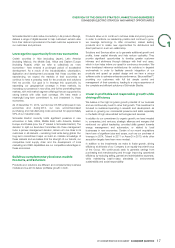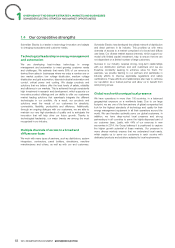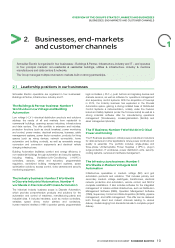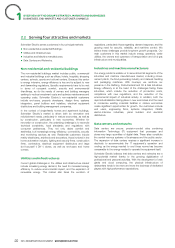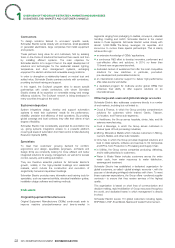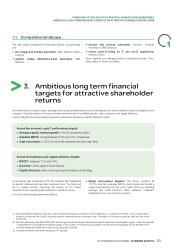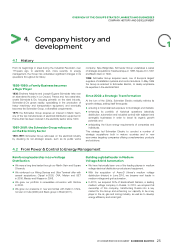APC 2014 Annual Report Download - page 17
Download and view the complete annual report
Please find page 17 of the 2014 APC annual report below. You can navigate through the pages in the report by either clicking on the pages listed below, or by using the keyword search tool below to find specific information within the annual report.
OVERVIEW OF THE GROUP’S STRATEGY, MARKETS AND BUSINESSES
SCHNEIDER ELECTRIC STRATEGY AND MARKET OPPORTUNITIES
Schneider Electric delivers urban efficiency as a trusted partner infrastructure to meet the growing demands for standardized and
to drive collaboration and buy-in of all stakeholders - local and cost efficient offerings. In Mature Countries, Schneider Electric will
1
regional governments, private companies, utilities, real estate continue its focus on solution and identify opportunities for further
developers, and investors. We provide comprehensive solutions by services development, to contribute toward the reindustrialization/
bringing in proven technology, integrating operating and efficiency improvements in these markets.
information systems, and enabling connected, unified approach to
Digitization
decision-making. Schneider Electric already works with more than
250 cities across the world, and helps provide visible benefits to
cities and their constituents: In the past 20 years, Internet has connected 2.5 billion people
up to 30% energy savings;
l
together. In the coming eight years, this number will double.
Concurrently the Internet will connect 40 billion machines to those
up to 15% reduction of water losses;
l
5billion connected people. The increase in connectivity and
up to 20% reduction of travel time and traffic delays;
l
access of real-time information is changing our personal and
as well as environmental, social and economic benefits.
l
professional life: companies are digitizing their operations, often
times through SaaS providers; customers are expecting to have
Industrialization
everything online, from e-training to e-ordering and digital care
centers; and employees are increasingly using online platforms and
tools to collaborate more efficiently across countries and time
Industrialization is driven by increase of factories in New zones. Digitization is changing the way we work and creating
Economies, on higher demand for goods, and efficiency opportunities for new services.
improvement as well as retrofit in Mature Countries.
In energy management, operational technology (OT), the world of
Manufacturing activities rise as New Economies develop. In 2014, physical equipment control, is converging with information
new economies represented 38% of world GDP – and this should technology (IT), the world of information processing. Products are
reach close to 54% by 2030. Significant step-up in industrialization now connected and can be remotely controlled and optimized.
will follow. Population growth in New Economies will also drive This results in the feasibility to implement active energy efficiency,
increased needs for manufactured goods with 1.8 billion people which creates new business models and new opportunities in
entering the global consuming class by 2025. smart products, systems and services – such as smart grid and
At the same time energy needs will increase accordingly. The share smart factories.
of global energy demand of non-OECD will continue to rise – from A smarter grid combines smarter supply (the efficient integration of
60% in 2014 to close to 66% by 2030 – because of renewable energy sources, flexible distribution), smarter demand
demographics, industrialization, urbanization, and growing (energy-efficient sites and homes, connected to the grid), and
affluence. Capex in new economies will also increase accordingly, demand response to balance the two. Schneider Electric is active
from 52% of world Capex in 2014 to close to 61% by 2030. in five key domains of the smart grid: flexible distribution,
In addition to the growing industrialization of emerging market, renewable energy integration, efficient buildings, electric vehicle
there is a movement of industrialization development in some charging infrastructure and demand-response. Recent acquisitions
mature economies such as the United States. In particular, the have considerably strengthened our play – from Areva’s
shale gas development leads to strong investments in the chemical Distribution business to Energy Pool and Vizelia in 2010 and
and petrochemical industries. At the same time the drop in energy Summit Energy and Telvent in 2011.
price and the decrease in labor prices have resulted in re-location In smart factories, all manufacturing units including assembly lines
of some manufacturing plants. In many Mature Countries, as most and robotics are connected and automated with minimum human
companies are looking for efficiency and facility upgrades, services inputs. Through real-time data collection and analysis, production
and other attributes in manufacturing (e.g. innovation, time to process can be automatically diagnosed, configured and
market, IoT) are also becoming more important and driving optimized. Consequently product defects, production downtime
additional growth potential. and waste can be reduced, resulting in higher manufacturing
The growing trend of industrialization promises business growth efficiency. Together with OT sensors and control devices, industrial
and expansion opportunities for Schneider Electric. For long term software is the core of smart factories. With the acquisition of
sustainable development in New Economies, Schneider Electric will Invensys, Schneider Electric has significantly strengthened its
continue to focus on combining its global value chain with local industrial software offering, especially in operations management,
partnerships to contribute toward the economic development for process management as well as industrial automation
through job creation and poverty reduction, in addition to applications.
investments in production capacity and physical & technological
15
2014 REGISTRATION DOCUMENT SCHNEIDER ELECTRIC


